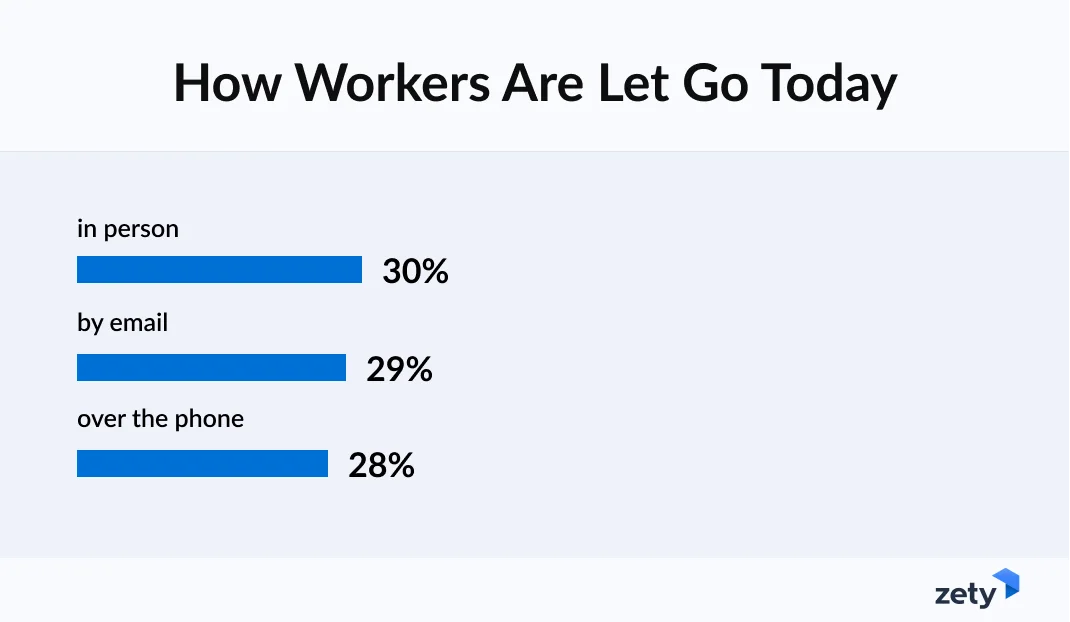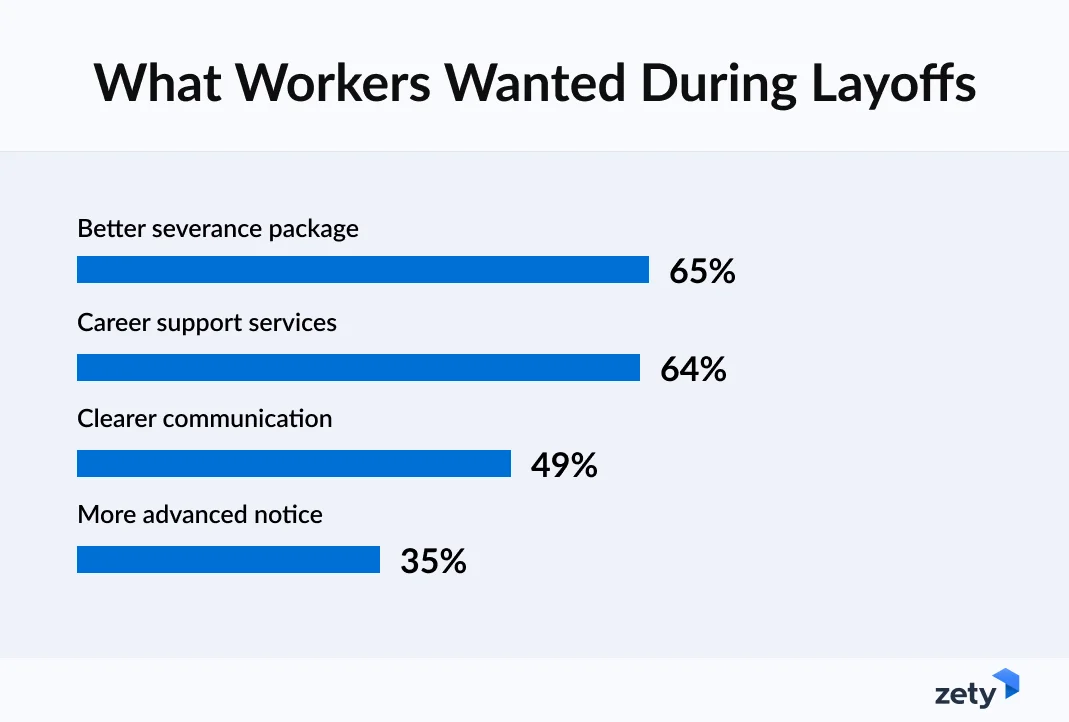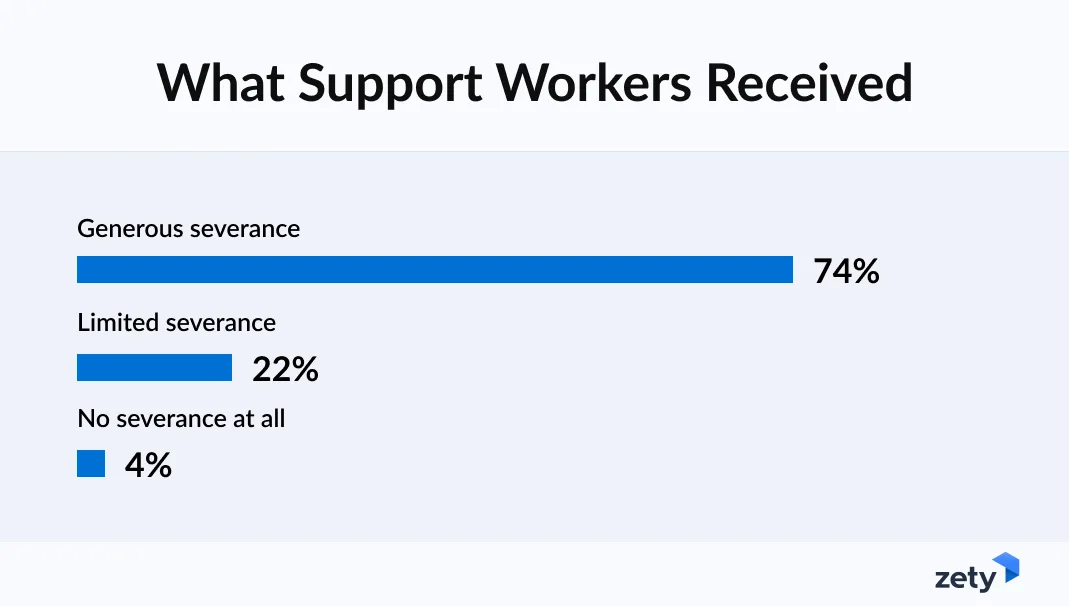Only 1 in 3 Redundant Workers Got Laid Off Face-to-Face
Create your CV nowGetting fired is stressful enough, but when you add an impersonal, robot-like approach to how some companies handle that situation, you get a truly horrifying scenario. And that’s what many workers face these days.
Whether they learn about it via email, over a phone call, or through a sudden loss of access to their work accounts, the way redundancy is delivered can have a profound impact on how it's received and remembered. Zety surveyed nearly 1,000 workers to learn about their redundancy experiences, and this article presents the results.
Key insights:
- Nearly 30% of surveyed workers were fired via email, and 28% were fired over the phone, with only 30% experiencing a face-to-face dismissal.
- Only 3% of workers in the UK find receiving redundancy notices by email acceptable, indicating strong resistance to remote terminations.
- 70% of surveyed workers reported job loss in the past six months. That’s a sharp increase linked to cost-cutting and structural changes.
- 43% of UK employers offer enhanced redundancy pay to support their employees' financial well-being, with many exceeding legal obligations.
When getting the sack feels like a digital shock
The rise in remote terminations is likely due to the increasing prevalence of remote work. With 63% of workers working entirely remotely or in a hybrid setup, this may seem like a logical explanation.
According to the study we’ve conducted on a thousand American workers:
- 29% of workers were fired by email.
- 28% of workers were fired over a phone call.
- Only 30% were let go during a personal, face-to-face, human interaction.

Digitalisation has overtaken human interaction, even in challenging, potentially life-changing moments. Remote dismissals are a quicker and less resource-intensive method of termination. While remote work has become more widespread, its use in layoffs highlights a growing detachment in how companies manage workforce reductions. They often prioritise operational efficiency over personal connection. There’s a minor silver lining, though: if it makes you upset, know that you’re not alone.
What about the UK?Thanks to attitude polls conducted by YouGov, we know exactly how Britons feel about this way of letting someone go. Data revealed strong distaste for remote notification:
- Only 3% of respondents think it’s acceptable to be let go by email, and 7% think it’s “somewhat acceptable” to receive such an email.
- Among small‑to‑medium employers, just 2% believe email is an appropriate method, compared with 11% for a phone call and a 98% preference for face‑to‑face notification.
The results aren’t surprising: an inhumane termination makes you feel there is nothing you can do. It damages morale, erodes trust, and leaves a negative impression of the company and the people you’ve worked for.
What’s driving job losses in Britain today
Many businesses in the UK are concerned that the new Employment Rights Bill, which bans zero-hours contracts and provides immediate unfair dismissal protection, will raise costs, lead to more tribunal claims, and limit staffing flexibility. While it aims to improve job security and work-life balance, some argue it places too much pressure on employers.
Zety’s survey established that 70% of American workers have lost their jobs in the last six months. That’s a sharp rise compared to the 17% fired in the last year and 13% in the last two years. The reasons for these terminations primarily stemmed from changes in company structures:
- 54% were laid off due to cost reduction.
- 45% were laid off due to company downsizing.
- 44% were laid off due to poor financial performance.
- 39% were laid off due to mergers or acquisitions.
- 53% of these workers said their redundancy was entirely due to company changes.
- 42% claim their performance might have influenced the decision, but it wasn’t the main reason.
- Only 5% believed they were made redundant due to poor performance.
How does the situation compare to the UK? Between May 2024 and May 2025, the UK experienced a decline of approximately 135,000 payrolled employees, representing a 0.4% drop. The number also fell by 25,000 (0.1%) from April to May 2025, which might suggest a general spike in redundancies.
UK employers upping their support game
While redundancy is never an easy experience, many UK organisations choose to go beyond statutory requirements to support their people through this difficult time. Whether recognising service, softening the financial blow, or simply showing that they value their workforce, employers are adopting a range of measures to help the departing staff.
What happens after the redundancy? We asked US workers what would have made the experience less painful. Here’s what they told us:
- 65% wanted a better severance package
- 64% wanted career support
- 49% wanted better communication
- 35% wanted more advanced notice

We also asked them what support they received:
- 74% received a generous severance package
- 22% received a severance package, but it wasn’t excellent
- 4% received no severance package

Are these business practices similar in the UK? The CIPD Labour Market Outlook gathered the following feedback from laid-off employees:
- 66% of employers provided some redundancy pay to those with under two years’ service.
- 17% of employers paid nothing to staff with under two years’ service.
- 43% offered enhanced redundancy pay specifically to support employees’ financial well-being.
- 37% used enhanced pay to encourage voluntary redundancies and reduce compulsory layoffs.
These practices demonstrate that, even in challenging circumstances, many UK employers strive to treat people with fairness and consideration. By offering discretionary pay, practical notice arrangements, and opportunities to explore other roles, businesses help staff transition with confidence and maintain positive relationships that ultimately benefit everyone.
From setback to comeback: your redundancy action plan
With the right approach, you can transform this challenging moment into an opportunity for reinvention and growth. Whether you’re seeking to secure the best possible package, maintain your professional network, or upskill for your next role, having a clear plan makes all the difference.
Here are practical tips to help you navigate the process with confidence, ensuring you emerge stronger on the other side:
- Know your rights: Check your entitlements on the governmental redundancy guidance.
- Negotiate your package: Even if you’ve under two years’ service, ask for a discretionary top‑up.
- Access free support from the Acas website or your local job centre.
- Keep connections alive and stay in touch with colleagues on LinkedIn and alumni networks.
- Plan your next move: Refresh your CV, write a cover letter, and learn more about interview practices.
From my own experience, I know well that redundancy can feel cold and unsettling, especially when it happens remotely or without much notice. However, by understanding your rights and seeking fair treatment, you can protect your interests during this difficult time. Don’t worry. You got this.
Methodology
The findings were collected from nearly 1,000 U.S. employees who had been laid off in the past two years. Participants responded to questions about their layoff experiences, including yes/no prompts, scaled questions assessing agreement levels, and multiple-choice options. Other data used in this article have been sourced from reputable governmental sources.
Sources
- Gov.uk, (2024) Factsheet: Employment Rights Bill - Overview
- Bon E., (2025) Labour Market Outlook - spring 2025, Chartered Institute of Personnel and Development
- Hooson M., (2025) UK Remote and Hybrid Work Statistics 2025
- YouGov UK, (2025) Generally speaking, do you think it is acceptable or unacceptable for a company to tell an employee they have been sacked by email?
- Clark G., (2011) Subject: You're fired
- Office for National Statistics, Redundancies
- Barnett J., (2025) Businesses to cut staff and raise prices after national insurance rise



